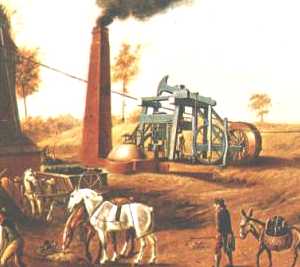|
THE
INDUSTRIAL
REVOLUTION
Inventor,
Thomas Newcomen installed the first practical steam
engine at Tipton, Staffordshire in 1712.
He used the engine to pump water from the
workings of the Coneygre Colliery, for the next thirty
years.

Coneygre colliery 1712
Newcomen’s
invention was an ‘atmospheric engine’, using steam
as a convenient way of forming a vacuum.
Nevertheless, he was the first man to harness
power by means of a piston.
The engine was undoubtedly the forerunner of
subsequent steam machines and played a vital part in
Britain’s Industrial Revolution.
James
Watt made a great many improvements by condensing the
steam outside the cylinder itself.
He also closed the cylinder at the top and used
low pressure steam to drive the piston down.
Then, came Richard Trevithick, who harnessed high pressure
steam to develop the Cornish beam engine.
Yet, the later engine very much resembled
Newcomen’s engine.
Over
the next 200 years Britain blazed a trail, using steam
engines to pump water, to operate looms in textile mills
and many other industrial applications.
The main ingredients of this success, were coal,
water and engineering skill.
The steam engine was later to be used as the
prime mover in the coming of the modern age.
MAGNETISM
AND ELECTRICITY
In
1801 Alessandro Volta
demonstrated his ‘Pile’ to Napoleon.
The pile was a series of copper and zinc discs
interleaved with moist cloth, to form an electric
battery. 20
years later in 1821 Michael Faraday invented a simple
single-wire electric motor and then in October 1831
Faraday succeeded in generating an electric current
mechanically. He had invented the dynamo using a bar magnet and a coil of
copper wire.
Volta’s
‘Pile’ was a primary cell.
A primary cell is one where the metals are used
up in a chemical exchange, which releases energy –
generally they cannot be recharged.
A secondary cell, uses a chemical reaction which
is reversible. By
putting electricity in, the cell can store energy
chemically, which can later be drawn out when needed.
Secondary cells were called accumulators in the
early days, because they accumulated a charge.
The Lead-Acid cell is one of the most common
accumulators or batteries.
These days we use them in cars for starting the
engine. After
starting, the engine turns a generator to recharge the
battery for the next time the engine needs starting.
Herstmonceux
Electricity Generating Works Circa. 1900 - 1936
Introduction
| Instructions
| ISBN
| Batteries
| Boiler
Room | Floor
Plan | Ron
Saunders
Industrial
Revolution
| Lime
Park | Machinery
| Map
| Power
House | Argus
1999
Public
Supply | Roof
Construction | Rural
Supply | Sussex
Express 1913 |
Conclusion
Archaeology
South East
| East
Sussex CC | English
Heritage | SIAS
| Sx
Exp 1999
Memories
of Herstmonceux by Margaret Pollard
|